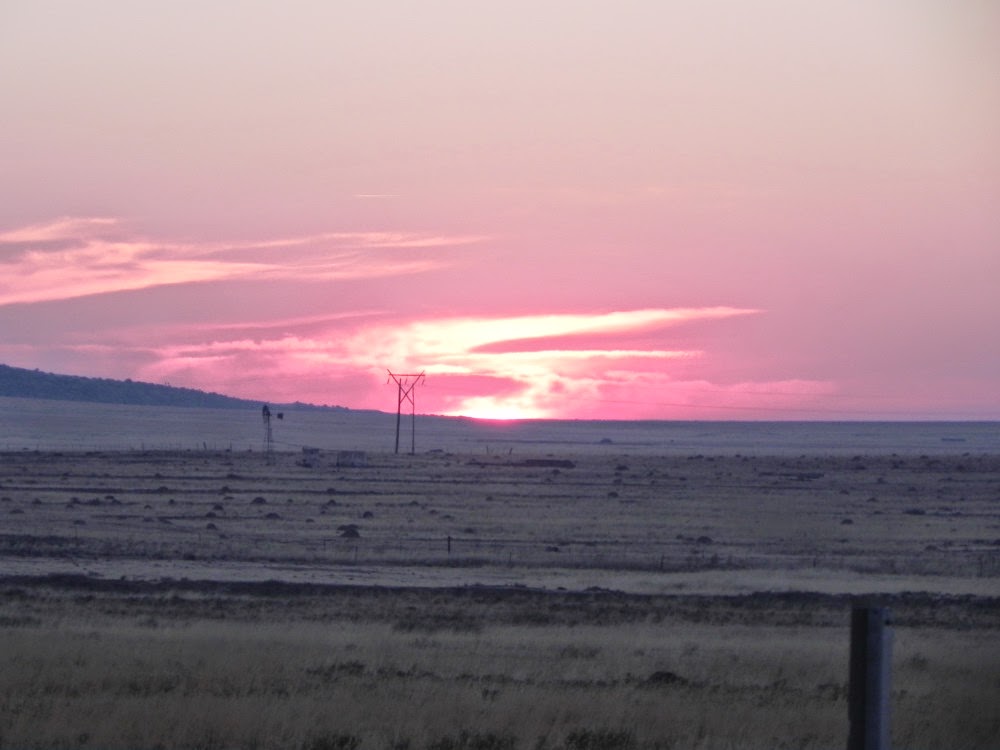Recently I was privileged of having a young
scholar join me in her quest to be more exposed to the world of our Cape
Vultures in the Eastern Cape. Her name is Adele Venter and she is presently
completing Grade 11 at Aliwal North High School. All Grade 11’s in this school have to spend a
week shadowing somebody or an organization, in the field they are interested
in. We were able to visit a couple of
sites during that week.
 |
| Adele Venter looking at vultures at Thomas river |
 |
| Thomas river |
Our first stop was the colony at Thomas River. This
roost is known as the Stonehenge colony.
Most of the vultures that utilize this site use it as a roost and not a
breeding site. I have on previous
occasions picked up two nests guarded by adult birds; however, none have produced
any chicks.
We left Rookwood just after 05h30 to be able to reach the viewing
site just as the sun rises.The road down to the site is not for the
average sedan and requires some careful negotiation.
 |
| Cape Vultures catching the early morning sun at Thomas River |
Once we reached our vantage point, we could
count and observe these magnificent birds sunning themselves on the
kranzes. While we are there, we make a
list of all the other birds seen at the site. This morning the vultures are
reluctant to leave their roost so after three hours we leave them to continue
to catch the winter heat on their kranz.
Our next visit is one that was not too successful due to the adverse windy conditions. We drove up to a vulture restaurant in the Elliot area. To get there we took the route through Lady Frere and Cala up to Elliot.
 |
| The mountains of the Elliot area |
 | |
| White necked Ravens and Ibises feeding at restuarant |
The Xonxa dam was clearly visible as we
descended the Nonesi pass down to Lady Frere and we were lucky to pick up a
vulture in the skies on the pass towards Cala.
This restaurant is supplied with food from a local abattoir and
approximately 80 Cape Vultures together with White-necked Ravens, Pied Crows,
and Sacred Ibises make use of this supply. There are small breeding colonies in
this area and the vultures can consider themselves lucky to have this supply of
food nearby. On this day we counted more than 100 White-necked Ravens, three Pied
Crows, and 25 Sacred Ibises with one lone Cape Vulture.
Our next stop was the famous colony of the Karnmelkspruit. Karnmelkspruit is a river that descends out of the tail of the Southern Drakensberg escarpment on the border between the Eastern Cape and Lesotho.
 |
| a view of the Witteberg range near Lady Grey |
 |
| the Kraai river |
It is a tributary of the Kraai River in the Senqu area in the north-eastern part of the Eastern Cape. The colony can be found in a magnificent gorge that is further down the river.
 |
| the gorge on the Karnmelkspruit river |
 |
| Ian and Adele looking at the vultures |
We were accompanied by Ian Cloete owner of the
property where this gorge flows through. Watching the birds flying above us and
then descending to eye level before dropping down onto their roosting kranzes was
absolutely wonderful.
 |
| Cape vultures roosting on the side of the gorge |
The next morning we counted all the vultures and
surprisingly found some nests on the kranz opposite Ian’s property where they
normally do not build nests.
Ian, together with the neighbour’s staff member
took us around to the other side of the gorge and we spent a couple of hours
counting all the nesting vultures.
 |
| Nesting Cape Vultures |
 |
| Cape Vulture flying above us |
Cape Vultures breed during the winter season and
sit on their eggs for more than 50 days.
We were lucky to watch the pairs ‘change’ incubation duties while we
were there. The sound of the wind in
their wings as they flew past us is a very special experience.
Sadly we had to take leave of this
magnificent area and head home. I stopped at Adele’s home
before returning to Rookwood.
Adele has now returned to school and I am confident
that she will have a ‘different’ type of shadow week experience to share with
her educators and class mates.
 |
| the rising sun on our journey |
Two weeks later I was given the task to collect
a rehabilitated Cape Vulture and the request was to release the bird at
Karnmelkspruit. Joy accompanied me on this long journey.
What a privilege to be able to watch this precious
bird step out of the crate, stretch her wings, watch the other birds
coming in to roost and finally take off across the gorge to land on a ridge
amongst a group of Cape Vultures. She had made it safely back home.




No comments:
Post a Comment